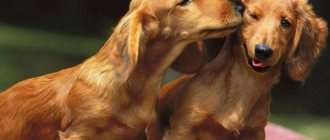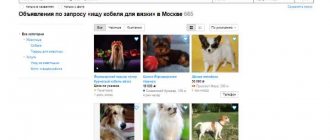Dog mating (or, as beginners often call it, “dog mating”) is the process of mating a male and female dog to produce offspring. If you have decided to knit your girl, but you have a lot of questions, then perhaps this article will be useful to you. Puberty and, accordingly, the ability to reproduce, appears quite early in dogs. Males, while still just puppies - at the age of 5-6 months, already breed a bitch. Therefore, do not underestimate your “babies” and leave them alone with girls in heat. A bitch can become pregnant even during her first heat (at 6-7 months!).
Early matings adversely affect the health of both males and females. A bitch's young, immature body is not able to withstand the colossal load caused by pregnancy, childbirth and feeding puppies. And early matings of males that have not yet completed their formation are fraught with problems in the future.
The bitch is ready for mating no earlier than her second or third heat (approximately 15-20 months). Favorable days for mating most often occur on the 11-13th day from the start of estrus. But practice shows that this is not always the case. For example, one of my bitches mates on day 9-10 (estrus lasts only 14-16 days), and the other, when in heat for almost 30-odd days, mates until day 17-18.
| Mating usually takes place on the dog's territory, that is, the bitch comes to the dog's home. Some owners breed their dogs on neutral territory. Both dogs must be walked before mating. There is no need to feed dogs before mating. When mating, help the dogs so as not to disturb them or frighten the dog. The owner of the bitch holds her by the neck, turning her back to the dog. The owner of the dog holds the bitch by the stomach so that she does not twist or sit down. If the male is smaller than the female, and when mounting the cage does not reach the loop, build something like a step. There is no need to force a male dog onto a bitch, otherwise you may scare him for life. If after several unsuccessful cages the dog is tired, then you can take him outside. Don't let him off the leash and walk him for 15-20 minutes. When you return to the bitch again, the dog will become even more interested in her. |
On peak days of estrus, a bitch mates very willingly: she stands completely still, moves her tail, places a loop and the penis penetrates there easily. After the male manages to insert the penis, he sprays sperm into the bitch. At this moment, blood flows abundantly to the bitch’s genitals, they swell greatly and tightly envelop the male’s penis - gluing, or locking, occurs.
| male mounts bitch | male and female in the castle |
Dogs can stand in the castle from a couple of minutes to an hour or even longer.
The dog is helped to take a comfortable position - his hind leg is carefully thrown over the bitch's croup (the dogs turn their tails towards each other). Sometimes the male does not show the desire to turn around completely, so you should not “force” him - let him stand to the side of the bitch if he is more comfortable that way. When dogs are in the castle, do not leave them alone. Make sure that the bitch does not sit down and tuck her legs, or try to run away or bite the dog. Any sudden movements can seriously injure a male dog’s penis and even lead to a fracture of the penis bone.
Dogs have matings when the lock lasts only a minute or two or is absent altogether. But this does not mean at all that the mating will be empty. The main thing is that the sperm gets into the bitch's genital tract.
After the dogs separate, a certain amount of light, sometimes bloody, liquid flows out of the bitch’s loop. There is no need to turn the bitch upside down and lift her hind legs, as many craftsmen advise, supposedly to stop this. What comes out of the bitch is not sperm at all, but lubricant, which is sometimes called propulsive fluid.
It makes sense to carry out the second mating (breeders call it control) no earlier than 24 hours after the first. The period of heat in a bitch may not coincide with the period during which eggs are capable of fusion with sperm. Sometimes this discrepancy is very significant, and a bitch mated during the hunt remains unfertilized precisely because several days pass from the start of the hunt to the maturation of the eggs.
Planned matings
Today, the problem of obtaining puppies is mainly dealt with by the relevant clubs. Dogs whose owners are members of the club are given directions for mating through the board. After certain procedures, their puppies are issued passports with a pedigree. However, as before, this practice does not guarantee the production of offspring from dogs with high working qualities. First of all, the selection is based on exterior criteria (appearance).
This is the age-old problem of dog breeders: the person managing the vouchers, first of all, “will not offend” himself and his friends, and may be tempted by a monetary reward. After all, the puppy’s working qualities do not immediately appear. Only then do owners wonder why third-party dogs work better. I remember similar complaints from dog breeders back in Soviet times.
Is it possible not to breed a bitch with a male?
Hello. I read an article on your website about a male dog (that it is permissible not to breed him), but what about a female dog? What are the consequences if you don’t reduce it?
Answer 1
Dog owners believe that the first mating is necessary for the health of the dog. The first mating of a bitch with a male dog can bring greater danger to the well-being of the animal than the complete exclusion of mating.
Pregnancy and childbirth of a dog provoke additional stress on the body. Subsequent feeding of the offspring continues to exhaust the bitch. Against this background, identified diseases may worsen, and new diseases that were previously unknown may appear.
To avoid serious consequences, before mating you should:
- Undergo a medical examination to determine hidden, chronic diseases. This will save the pet’s life during pregnancy and labor. It is dangerous to have a sick animal.
- Check the dog's well-being. A bitch can become infected with sexually transmitted diseases from her partner.
If the pregnancy proceeded without complications, labor may pose a threat to life. Difficulties in delivery can lead to surgery (caesarean section) and the death of the animal.
After the first mating, you will have to regularly breed the bitch, as hormonal changes in the body occur. For a dog's health, it is necessary to periodically produce offspring. Refusal to mate leads to false pugnancy (manifests itself in behavior - behaves like a pregnant woman, looks for objects that replace puppies). It is observed in bitches who have given birth once. Sterilization after one mating will not exclude breast cancer and pyometra (purulent endometritis that accumulates in the uterine cavity). Oncological disease is more often detected in bitches mated singly.
To avoid health problems for your female dog, it is better to spay your pet before her first heat. The older the animal, the more difficult the postoperative period is. Removing the uterus and ovaries avoids malignant organ formations.
This does not affect the psychological state of a pet that avoids sexual contact and does not affect its life expectancy. But it will eliminate problems with the health of the animal.
Unplanned matings
Therefore, among dog breeders, unplanned matings of dogs are often practiced, when offspring are obtained from parents who work excellently in the rings of exhibitions and demonstrations, but do not have access to vouchers. By the way, by avoiding close crossing - inbreeding, such dog breeders practically do not reject puppies, let alone referrals from the club (such matings often produce puppies with an incorrect bite and skeletal structure). True, a puppy from an unplanned “marriage” is not awarded an enviable pedigree on paper, despite the purebred nature of the father and mother (how could they be bred without permission). However, the path to understanding the skill of training and its demonstration, and most importantly, selfless service to its owner, is always open to such a dog.
So, if you are not a member of the club, or your pet is from an unplanned mating, finding a partner for the dog falls on you - the owner. If possible, meet dog breeders, go to exhibitions, participate in competitions in the OKD, ZKS courses, and in demonstration performances (you will have to pay for participation). If you take prizes, dog breeders themselves will find you with an offer for breeding pets.
Methods for determining favorable days for mating bitches.
Just yesterday, for the first time, I tried to determine a favorable day for breeding a bitch based on a vaginal smear. The onset of heat was noticed 6 days ago, but there were suspicions that the bitch had started heat earlier. We decided to try to look at the smear and came to the conclusion that the bitch was already ready for mating. She got involved “on the fly.” I'll post the results in a couple of months. 
I used the method given below.
You must have:
1. Microscope with magnification from 80 to 300 (more is possible). To find out the magnification of the microscope, you need to multiply the magnification of the eyepiece (for example, 10) by the magnification of the objective (for example, 8). We get 10x8=80
2. Glass slides (on which we will apply a smear).
3. Cover slips (with which we will cover the slides). If you do not find coverslips, you can cover the smear on top with a second slide.
4.Water without impurities (distilled or buy water in ampoules at the pharmacy).
5.Ear cleaning sticks (human).
6. Dye (I used methylene blue, sold in pet stores for aquariums, but you can use stamp paint - sold in office supplies, the effect is the same). Some people buy fukortsin at the pharmacy for staining, then the smears will not be bluish, but reddish.
7. Dye pipette
You can take a smear when the bitch is lying down (whichever is more convenient for you). When taking a smear, it is advisable to take it from the upper vaginal vault, wiping it thoroughly with a cotton swab.
Technique:
1. Take a clean glass slide, well washed and wiped dry, and place it on a clean napkin.
2. Take a cotton swab, dip it in distilled water, shake the stick in your hand several times to remove excess water.
3. Using a damp stick, take a swab from the bitch, inserting it deeper into the loop (2-3 centimeters), as if wiping the loop from the inside, without touching it with your hands (from the upper arch).
4. Roll this stick over the slide (without pressing too hard so that the layer of the smear is not thick. Visually you will see a cloudy strip on the glass - this is your smear that needs to be painted over.
5. Apply one drop of dye to the smear with a pipette, carefully cover with a coverslip so that there are no air bubbles.
And you can look through a microscope
What cells can we see there:
1. Parabasal (round with a large nucleus, small in size)
2. Intermediate (rounded, with a more transparent cytoplasm, the nucleus decreases, the cell increases due to plasma, larger than parabasal)
3. Superficial cells (estrous scales) are exactly what interests us. During fertile days, almost all cells should be exactly like this; intermediate cells may be present in a single quantity.
Estrous scales line up in chains (gluing), but in some bitches gluing does not occur, but fertilization occurs. The cells seem to overlap each other (like tiles), located perpendicular to each other, the contours of one cell are easily visible through the transparent cytoplasm of the other.
At a magnification of 80-120 we look at the general background, at a magnification of 300 and above we look at the cells.
During the rest period, we will see single cells against the background of leukocytes (leukocytes are smaller, like splashes or sand scattered across the field of a smear).
Examples of strokes
Day 1 (In this case, this is the first day of taking a smear, and not the beginning of estrus, it coincided with the end of proestrus). Usually, smears begin to be taken from the 6th-7th day of estrus.
Proestrus (intermediate cells and a large number of erythrocytes and leukocytes, superficial cells - single). Red blood cells and white blood cells are small, in the form of sand. On the smear, the leukocytes are the smallest and dark blue in color. The background of the stroke is translucent (cloudy).
Day 2 – Beginning of estrus (there are many surface cells, but there are still a large number of intermediate cells, there are noticeably fewer leukocytes, the background of the smear clears, it becomes blue and cleaner, more transparent)
Day 3 Estrus, the beginning of fertile days. Conception is likely. (almost all cells are superficial - polygonal, nuclear-free. Intermediate cells and leukocytes are in small quantities, the background of the smear is clean, light blue).
Day 6 Estrus, fertile days (almost all cells are superficial, leukocytes have practically disappeared, the background of the smear is clear, light blue, like the sky). The ideal time to conceive.
Day 9 Estrus, end of fertile days (almost all cells are superficial - polygonal, nuclear-free. A small number of intermediate cells are round, with a small nucleus. Leukocytes appear in small numbers, the background of the smear is transparent, light blue).
Day 10 Estrus, end of fertile days (almost all cells are superficial - polygonal, anucleated. Keratinization intensifies. The number of leukocytes increases, intermediate cells appear. The background of the smear becomes not as transparent as it was).
Day 11 Diestrus. Conception is impossible (almost all cells are intermediate and basal, a large number of leukocytes. The background of the smear becomes dirty and cloudy).
Day 12 Diestrus, 2nd day. Conception is impossible (all cells are intermediate and basal, a large number of leukocytes. The background of the smear is dirty and cloudy).
Examples of cytological smears with explanations
Estrus, fertile days, all superficial cells are polygonal, the background of the smear is light, transparent. The cells seem to overlap one another.
A day favorable for conception.
Diestrus, conception is impossible. The cells are parabasal (with a large nucleus, round and intermediate (with a small nucleus). Superficial cells are absent or present in single numbers. A large number of leukocytes, the background is cloudy and dirty. The fertile period has passed.
information based on the book “English Bulldog” by Bailey S. Haynes
from the series: American Kennel Club Library.
Age for breeding dogs
Only mature dogs should be bred: males at 2.5 years, females at the fourth or fifth heat. It is best to mate a young male with an adult bitch, and a young female with an adult male.
The owner of a bitch during an interesting period with a dog should walk in a secluded place, and in no case allow crossing with other breeds or outbred dogs. There is an opinion among dog breeders that the genes from the first male dog will be passed on to all subsequent litters of the female dog. That is, if there was a mating with a mongrel dog, all subsequent puppies, despite the purebred of the following males, will be a cross.
As a rule, before breeding dogs, their owners determine how they will divide the offspring of the bitch. Typically, the owner of the bitch pays for the breeding or gives from one to three puppies to the owner of the male, depending on the number of offspring. In the case of planned matings, dog breeders enter into contracts, collecting penalties through the court.
Admission to mating and mandatory conditions
In order to register a mating with a canine organization and, accordingly, then receive documents (pedigrees) for the puppies, you need to fulfill a number of conditions.
If in the future, when you submit documents to the Russian Cynological Federation (RKF), at least some of these conditions are not met, you risk being left with puppies for which documents will not be issued. Firstly, age. At the time of mating, the female Chinese Crested dog must not be younger than 15 months, and the male must not be younger than 12 months. The extreme age also matters: the female must be no older than 7.5 years, for males there is no limit.
Bitches are allowed for breeding 6 times during the breeding period (read - during their life). Mating is allowed no more than once per calendar year. It is allowed to receive two litters in a row from one breeder, provided that the interval between births of litters is at least 6 months with a mandatory requirement for the breeder that the next litter from this breeder must be received no earlier than 365 days from the birth of the puppies of the last litter. Repetition of this periodicity is acceptable. But if you violate the specified intervals, then documents for the litter will not be issued.
Secondly, pedigree. At the time of mating, the male and female must have pedigrees of the Russian Canine Federation. Not the puppy cards that were given to you when you bought the puppy, but the pedigree cards - those light laminated pieces of paper. If the mating is very soon, and you don’t have the documents yet, then you can submit your puppy card to the RKF for an urgent pedigree (done within one day).
Thirdly, the assessment from the exhibition. Both dogs (male and female) must have a show grade (the so-called “breeding grade”). The assessment must be obtained before mating at the official RKF certificate show. For males this rating is not lower than “excellent”, for females - not lower than “very good”. Dog owners submit the original diploma to the RKF once when registering the first litter of their dogs.
Determining the optimal mating time
During estrus, serious changes occur in the dog's genitals. Her behavior changes, she becomes restless, she urinates frequently during walks, and discharge with blood appears. At this time, the bitch will not allow the male dog, she is not yet ready for mating. You must wait until the discharge becomes light and the loop swells greatly.
It is impossible to accurately determine the best day for mating; each organism is individual. On average, the optimal period is considered to be 10-13 days from the moment bleeding appears. You cannot start mating until the dog is completely ready for the process.
What are the requirements for the mating location?
When solving the problem of what is needed to breed dogs, you should initially decide on the choice of territory for this process. The owners of four-legged pets will not go wrong if they prepare the mating site in advance.
It is considered more correct for the “bride” to visit the “groom”, since otherwise a male dog that finds itself in an unfamiliar place may show uncertainty, be nervous, and refuse to mate. This is of particular importance when dogs are mated for the first time or the “bride” behaves too aggressively, her smell is weak and not attractive enough for the “groom”.
The choice of mating location is made taking into account the size of the animals. Pets belonging to small and medium breeds can be provided with a spacious room.
For mating of large individuals, it is advisable to allocate an outdoor fenced area so that the partners have a certain amount of space.
Experienced dog handlers who know how dogs are mated strongly advise giving preference to a secluded place where the animals will not be disturbed by passers-by or other dogs. The covering of the mating area should be non-slip. If the meeting of the “groom” with the “bride” takes place indoors, linoleum or parquet flooring should be covered with carpet or carpet. In winter, the slippery icy ground outside is sprinkled with sand.











